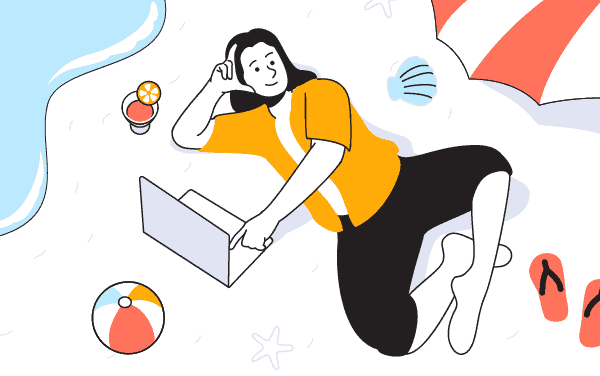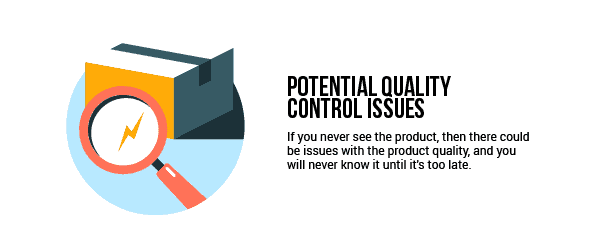Wondering what’s the difference between dropshipping and 3PL?
While the two can be easily mixed, they are quite different in practice.
The main difference between dropshipping and 3PL is that dropshipping does not involve buying inventory upfront, while 3PL involves working with a third-party partner and shipping inventory to them upfront.
In this article, we will go into this topic in more depth, explain the pros and cons of each, and help you decide which approach is the right choice for you.
Overview: Dropshipping vs. 3PL
Let’s start with an overview of dropshipping and 3PL!
Here is an explanation of what dropshipping is:
Dropshipping is an ecommerce business model in which an online store does not store inventory but acts as a middleman between the supplier and the customer.
Whenever a customer orders an item, the store sends the order directly to the dropshipping supplier, who then ships it to the customer.

And here is an explanation for 3PL:
3PL stands for third-party logistics, which means that an ecommerce website relies on a third-party fulfillment company for order storage, packaging, and shipping.
3PL partners do not work directly with the factories or manufacture the products, so the seller is responsible for doing the bulk order and sending the inventory to the 3PL partner.
Both of these fulfillment methods have their pros and cons, and here is an overview of them:
| Pros of dropshipping | Cons of dropshipping | Pros of 3PL | Cons of 3PL |
| Easier for beginners | A less reliable option for scaling | Can handle increased order volumes | More advanced option for beginners |
| Less upfront investment | Longer shipping times | Fast and consistent shipping times | More upfront costs |
| Lower overhead expenses | Potential quality control issues | Reliable with minimal quality control issues | More overhead expenses |
| Access to more products | Potential issues with customer satisfaction | Higher customer satisfaction | More limited product catalog |
What is dropshipping?
Dropshipping is a business model where you sell products on your online store without keeping any stock yourself. With dropshipping, you work with a dropshipping supplier who will take care of your stock, process your orders, and ship them out.

Here are four steps of how the whole process works:
- You receive an order in your online store and then place that order with your dropshipping supplier.
- Your supplier ships the product from their warehouse.
- Your customer receives their package directly from the dropshipping supplier.
Now that you know the basics of the dropshipping model, let’s dive into 3PL to make the differences even clearer!
What is 3PL?
3PL, or third-party logistics, is a form of fulfillment where you, the seller, rely on a third-party company to take care of warehousing, packaging, and shipping of products.
You can find 3PL partners from all over the world, but most are located in the US, Canada, Australia, the UK, and the EU. Many leading 3PL companies, like ShipBob, have warehouses in all of these countries.
Here’s what the process of using 3PL looks like:
- You source or manufacture the products, negotiate the bulk order deal, and find the sizes, colors, and variants. This can be done from Alibaba, for example.
- You ship a bulk order of your products to the 3PL fulfillment center for storage. Depending on what kind of deal you make, your 3PL partner charges you a fee for storing the products in their warehouse.
- When a customer places an order on your online store, your 3PL partner ships the product directly to them.
- Your customer receives the package from the 3PL partner.
- You keep track of the inventory to make sure your 3PL partner always has products in stock to ship. When the products are running low on stock, you place a new bulk order from your manufacturer.
The pros and cons of dropshipping vs. 3PL
The most apparent difference between dropshipping and 3PL is how products are fulfilled.
With dropshipping, you don’t invest in any inventory since your supplier fulfills on an order-by-order basis. In contrast, with 3PL, you’re responsible for sending enough inventory to your 3PL partner so they can keep fulfilling orders.
Interestingly, 3PL could be considered a form of dropshipping since you, as the seller, are not holding any inventory.
For this pros and cons section, we will compare the two methods in their most common form:
- Dropshipping. Selling products on your online store with the help of a dropshipping supplier.
- 3PL. Selling products on your online store with the help of a third-party logistics company.
Pros of dropshipping (or cons of 3PL)
Let’s start with the pros of dropshipping, which are also the cons of 3PL fulfillment.
1. Easier for beginners
The biggest advantage of dropshipping is that it’s much simpler to get into than 3PL.

With 3PL, there are more steps, and it’s a bit more advanced for someone new. Plus, it doesn’t make much sense to start with 3PL if you have no previous experience dropshipping or haven’t validated your product idea.
This is because if your product doesn’t end up selling well, you have wasted money on the inventory that sits unused.
2. Less upfront investment
With dropshipping, you don’t have to invest in buying inventory upfront, which gives you huge savings.
Unlike with 3PL, you have to invest in a stock, and usually, 3PL companies have a minimum order quantity that you have to meet.

For example, if the minimum order quantity is 100, you need to ship 100 products to your 3PL partner just to get started.
Dropshipping suppliers typically do not have a minimum order quantity.
3. Lower overhead expenses
If you want to get a better idea of what costs are exactly involved with dropshipping, we have written an entire article on it:
How Much Does It Cost to Start Dropshipping in 2024
The above costs are calculated if you just use a basic dropshipping supplier. It is way cheaper if you compare that to using a 3PL partner.
You may wonder about the different overhead expenses involved with 3PL and why it costs money. ShipBob has made an amazing table that showcases a common 3PL pricing model:
As you can see, there are many fees associated with 3PL companies, including charges for receiving your products and adding them to the self-storage unit, monthly storage fees, shipping, and pick-and-pack fees.
Many companies also have a minimum fulfillment spend for each month. For ShipBob, it’s $275, meaning you can’t spend any less than that if you use their 3PL services.
Then, on top of this, you have to add the other fees, like the cost of producing the products, your monthly ecommerce fees, and any third-party apps you use.
Adding all these up, you can be sure to have many expenses every month, and if you’re not making any sales yet, it can go wrong quickly.
4. Access to more products
There is no doubt that dropshipping gives you access to more products than 3PL fulfillment.
Since you don’t have to buy any inventory upfront, you can pretty much test unlimited new products until you find a successful one.
That is really not possible with 3PL since you have to buy a stock for every product.
Technically, it’s possible, but it would be a waste of money to buy stock for every product because not everything you try will sell well.
Cons of dropshipping (or pros of 3PL)
Next, let’s look into the cons of dropshipping, which are also the pros of 3PL!
1. Less reliable for scaling
If your dropshipping business is profitable and you actually want to start scaling, 3PL fulfillment will be more reliable than dropshipping fulfillment.
One reason for this is that 3PL partners have really high accuracy rate, and their shipping is fast. To use ShipBob as an example again, their accuracy rate is 99.95% for all their customers.

What this simply means is that almost 100% of the customers have received the correct products.
This is something dropshipping suppliers can’t offer at this high level.
Don’t get me wrong, most of the top dropshipping suppliers do have high accuracy in terms of how accurately the orders reach the customers.
Also, 3PL companies are typically more dependable, especially for advanced needs like omnifulfillment when scaling.

2. Longer shipping times and less control over them
Dropshipping suppliers, even those from China, have improved their shipping speeds.
If you use solutions like CJdropshipping, you can get your products shipped worldwide within 7 to 14 days.
However, these delivery times are still rather slow compared to what 3PL partners can offer. ShipBob, for example, is known for its two-day shipping across the US, which is unheard of by dropshipping suppliers.
Also, since 3PL companies usually have warehouses on most continents, they can get products shipped worldwide within two to seven days.
Another factor is how much control you have over your shipping.
With 3PL, you have more control over how things are shipped, what packaging to use, and even putting in your own ads or messages. This is because you work directly with the people handling your items, so you can tell them how to manage your products.
On the other hand, most dropshipping suppliers usually offer limited shipping options.
You can’t really decide on packaging or how fast things ship unless you have a good relationship with the supplier and are making enough money for them to consider any special requests.
3. Potential quality control issues
Anyone who has used AliExpress sellers as their suppliers may be familiar with the quality control issues.

If you have used AliExpress for a long time, it is pretty likely that some of your customers will receive low-quality or damaged products. When this happens, it can be hard to contact AliExpress sellers and receive any help with returns and refunds on the product.
Using a more well-known dropshipping supplier, such as Syncee or a private dropshipping agent, will partly solve this problem since they have better quality control processes.
However, the most reliable solution will be a 3PL partner since they have the most strict quality control processes.
4. Potential issues with customer satisfaction
One of the problems with dropshipping is potential issues with customer satisfaction.
To be clear, this is not always the case, but customers may be unhappy if your shipping takes too long or you cannot provide tracking numbers because you use some lesser-known shipping company.
As long as your product is of high quality and you’re also doing other things right, you will not face this problem when using a 3PL partner.
3PL partners provide tracking numbers to customers, and since they ship so quickly, there is very little chance that customers will complain.
Which business model is right for you: dropshipping vs. 3PL?

If you’re still not sure which of these two fulfillment methods is the right option for you, this section will help.
Dropshipping may be the right option for you if:
- You don’t want to invest a lot of money upfront.
- You want as little overhead expenses as possible.
- You don’t want to deal with buying inventory upfront.
- You want access to as many products as possible.
- You want more influence in handling and shipping your products.
3PL fulfillment may be the right option for you if:
- You want to take advantage of two- to seven-day shipping times worldwide.
- You’re already making sales with your ecommerce brand.
- You’re ready to invest in stock to increase your customer satisfaction.
- You want as little as possible problems with quality control.
Also, just to add an important point.
What we recommend doing for most people is starting with dropshipping fulfillment and then gradually switching to 3PL if you feel like it.
For example, you could start using the CJdropshipping China warehouses and ship your products from there. Once you get a consistent amount of orders every month, they also have warehouses around the world, which you can then start using if you want.
This way, you’re able to keep the costs down while still growing your business!
Compare other business models
Not sure yet if dropshipping or 3PL is the right fit for you? Check out our other comparison articles below:
Summary
Before we go to the conclusion, we’ve created a quick summary of this article for you, so you can easily remember it:
- Dropshipping is a business model where the seller sells products in their online store without keeping any stock themselves.
- 3PL is a form of fulfillment that involves the seller relying on a third-party company to handle warehousing, packaging, and shipping.
- The main difference between dropshipping and 3PL fulfillment is that with dropshipping fulfillment, you don’t have to buy inventory upfront, while with 3PL fulfillment, you ship inventory to a third-party partner.
- Dropshipping fulfillment may be the right option for you if you want to get started with minimal upfront investment, low overhead expenses, and the ability to test many products.
- 3PL fulfillment may be the right option for you if you’re ready to scale your ecommerce business and want fast shipping times, a reliable fulfillment system, and more satisfied customers.
Conclusion
That wraps up our comparison between 3PL and dropshipping!
Think of dropshipping as a starting point, perfect for when you’re just beginning. As your business grows, you might find 3PL a better fit because of its faster, more reliable shipping and fewer issues with product quality.
Did we miss any important points in this article? If so, feel free to let us know!
If you have any questions about these two fulfillment methods, remember that you can always leave us a question down below!
Good luck!
Want to learn more about dropshipping?
Ready to move your dropshipping store to the next level? Check out the articles below:
Plus, don’t forget to check out our in-depth guide on how to start dropshipping here!

